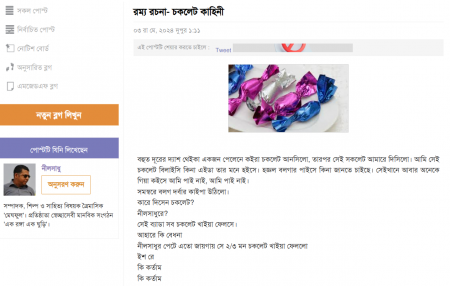In "The Fruitseller from Kabul", Tagore speaks in first person as a town-dweller and novelist who chances upon the Afghani seller. He channels the longing of those trapped in mundane, hardscrabble Indian urban life, giving play to dreams of a different existence in the distant and wild mountains: "There were autumn mornings, the time of year when kings of old went forth to conquest; and I, never stirring from my little corner in Calcutta, would let my mind wander over the whole world. At the very name of another country, my heart would go out to it ... I would fall to weaving a network of dreams: the mountains, the glens, the forest .... ".[82] Many of the other Galpaguchchha stories were written in Tagore’s Sabuj Patra period (1914–1917; also named for one of Tagore's magazines). Tagore's Golpoguchchho (Bunch of Stories) remains among Bengali literature's most popular fictional works, providing subject matter for many successful films and theatrical plays. Satyajit Ray's film Charulata was based upon Tagore's controversial novella, Nastanirh (The Broken Nest). In Atithi (also made into a film), the young Brahmin boy Tarapada shares a boat ride with a village zamindar. The boy reveals that he has run away from home, only to wander around ever since. Taking pity, the zamindar adopts him and ultimately arranges his marriage to the zamindar's own daughter. However, the night before the wedding, Tarapada runs off—again. Strir Patra (The Letter from the Wife) is among Bengali literature's earliest depictions of the bold emancipation of women. The heroine Mrinal, the wife of a typical patriarchical Bengali middle class man, writes a letter while she is travelling (which constitutes the whole story). It details the pettiness of her life and struggles; she finally declares that she will not return to her husband's home with the statement Amio bachbo. Ei bachlum: "And I shall live. Here, I live".
Haimanti assails Hindu marriage and the dismal lifelessness of married Bengali women, hypocrisies plaguing the Indian middle classes, and how Haimanti, a sensitive young woman, must—due to her sensitiveness and free spirit—sacrifice her life. In the last passage, Tagore directly attacks the Hindu custom of glorifying Sita's attempted self-immolation as a means of appeasing her husband Rama's doubts. Musalmani Didi examines Hindu-Muslim tensions and, in many ways, embodies the essence of Tagore's humanism. Darpaharan exhibits Tagore's self-consciousness, describing a fey young man harboring literary ambitions. Though he loves his wife, he wishes to stifle her own literary career, deeming it unfeminine. Tagore himself, in his youth, seems to have harbored similar ideas about women. Darpaharan depicts the final humbling of the man as he acknowledges his wife's talents. As do many other Tagore stories, Jibito o Mrito equips Bengalis with a ubiquitous epigram: Kadombini moriya proman korilo she more nai—"Kadombini died, thereby proving that she hadn't died in the first place".
সর্বশেষ এডিট : ০১ লা এপ্রিল, ২০১১ সন্ধ্যা ৭:৩৮


 অনুগ্রহ করে অপেক্ষা করুন। ছবি আটো ইন্সার্ট হবে।
অনুগ্রহ করে অপেক্ষা করুন। ছবি আটো ইন্সার্ট হবে।.jpg)








